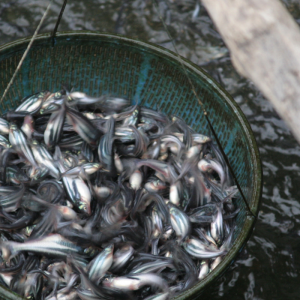
Effects of Green-Bodied Laying Dogs in Aquaculture
| Wed, 15 Apr 2020 - 14:56
Antibacterial properties and enhances the immune response of green-bodied laying dogs in aquaculture.
Antibacterial ability of laying green dog breeds
In the green tree itself bitch (Phyllanthus amanus ) contains a group of compounds such as:
1. Ankaloid group (with substances found like Isobubbialine, epibubbialine, phyllanthine, securinnie, norsecurinine)
2. Phenolic group (including: ellagitanin, hydrolysable tannins, proantho cyanidin, flavan-3-ol, shikimic (3, 5-O-gallate) acid).
3. Flavonoids and other acids (namely, amariinic acid, thiobarbituric acid, ascorbic acid (vitamin C), etc.)
Many scientific reports have also shown that phenolic and flavonide compounds have high antibacterial activity, using total phenolic and total flavonide concentrations as a criterion to determine antibacterial activity in efficacy testing tests. of extracts from dog hens or leaves.
Phenolic compounds from different plants have antibacterial activity against different microorganisms. When comparing the results of antibiotic map (measuring the diameter of aseptic ring), in the treatment of plant extracts with the concentration of 1000 mg / mL, the antibacterial ring diameter for Vibrio parahaemolyticus was 21.4 mm; in the doxycylin treatment with a concentration of 30 µg / mL, the antibiotic diameter was 19.8 mm; The ampicillin solution with a concentration of 10 µg / mL has an antibacterial diameter of 0 mm.
The antibacterial ring diameter of the green-body dog breed extract increases with increasing concentration. With an extract concentration of 250 mg / mL, the antibacterial ring diameter is 16,6 mm; similar to the concentration of 500 mg / mL is 18.2 mg / mL; with a concentration of 750 mg / mL is 20.6 mm; The highest was at a concentration of 1000 mg / mL 21.4 mm.
The ability to inhibit and kill Vibrio sp and V.parahaemolyticus cause AHPND disease in shrimp
This is shown by the ratio of MBC / MIC (Minimum bactericidal concentration / Minimum inhibitory concentration), if this ratio is less than or equal to 4, the extract is likely kill bacteria, on the other hand if this ratio is greater than 4, the extract only inhibits bacteria.
Experiments demonstrated that the MIC and MBC of the plant extract for V.parahaemolyticus were 125 mg / mL, respectively; 500 mg / mL, the ratio of MBC / MIC is equal to 4. Similarly with Vibrio sp, MIC and MBC are 62.5 mg / mL; 250mg / mL, MBC / MIC ratio is 4.
Enhancing immune response in pangasius ( Pagasionnodon hypothalmus )
Unlike shrimp, the body has an immune system. Therefore, there has been a lot of research on the effect of herbal essences on the immune system of fish in order to increase resistance against harmful bacteria and stressors. Phenolic compounds are secondary metabolites of plants that have a positive effect on human health because they have antioxidant activity.
In another study, phenolic and flavonide groups are the most prominent antioxidant compounds in plants and are very strong antioxidant compounds, proven to be stronger than vitamin C, vitamin E, and carotenoids. The results of the study showed that when supplementing with extracts from green-bodied laying dogs after 24 hours, the ROS activity (Reactive oxigen species) and the total antibody index of Ig leukocytes (Figure 2) of Pangasius increased significantly compared to the control treatment.
ROS consists of free radicals and some special molecules in the structure containing oxygen atoms that are capable of participating in strong oxidation reactions. When agents enter the body, neutrophils will be captured and activated neutrophils will increase the use of oxygen. At the beginning of phagocytosis, these cells use large amounts of oxygen and release enzymes such as NADPH oxidase (NOX); nitric oxide synthase (NOS) is involved in the transformation of O 2 , NO, Cl - to form ROS. ROS radicals will attack foreign antigens.
As for Ig antibody, an immunoglobulin-Igi glycoprotein is made from B lymphocytes (mainly antibody-producing plasma cells that are responsible for "capturing" the antigen and are able to bind to the antigen. The antibodies have 5 basic types: IgG, IgA, IgM, IgD, IgE.They have the common function of combining with antigens, bacterial agglutination, neutralizing toxins, preserving body protection.
Thus, the potential for application of green stem carrier extracts to prevent and treat aquatic animals is huge, especially in the treatment of Vibrio sp . And can be used in combination with EM preparations for better results.
Source: tepbac






















